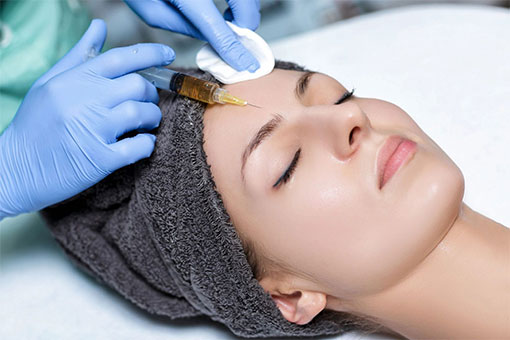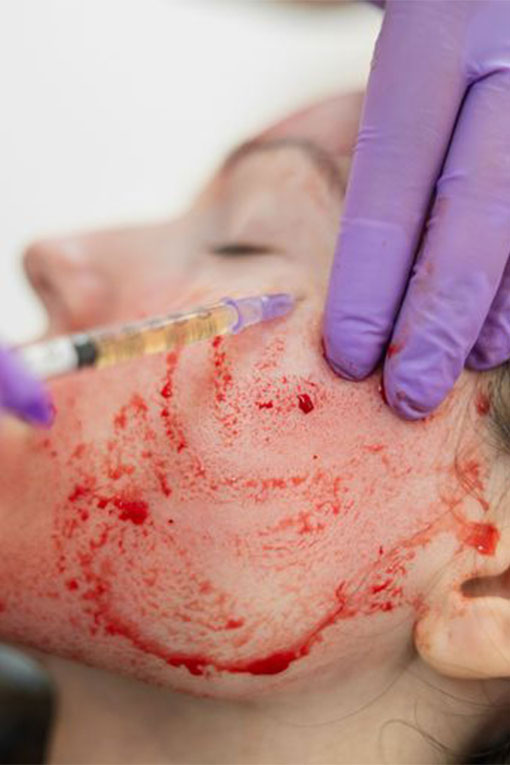Expert Cosmetics Since 2017
Choice of Five-Star Clinics
Friendly and Knowledgeable Team
PRP Facial
Platelet rich plasma or PRP therapy, also known as autologous rejuvenation therapy is a revolutionary new treatment which is often referred to by the media as either a ‘vampire facelift’ or ‘dracula therapy’. The therapy itself works on the basis that the body’s natural healing processes and powers can slow and in some cases even reverse the ageing process by positioning growth factors in the exact location where we need the skin to repair and rejuvenate.
PRP therapy works by harvesting platelets from the patient’s blood to inject them into the skin areas experiencing problems, giving a reason for the treatment to have the nicknames ‘Vampire Facelift’ and ‘Dracula Therapy’. Prior to the procedure, a small amount of blood will be taken from the patient and is placed in a centrifuge where the blood is spun at high speed to separate the blood cells from the platelet rich plasma. The plasma, which is the main component of the blood that is known to be highly effective in treating burns and skin injuries, is then injected into the chosen area to reduce fine lines and wrinkles whilst plumping up the skin.
Why choose a PRP facial?
PRP facial therapy is a wonderful solution to renew the youthful appearance of the skin on the face. By tapping into and using the natural “growth factors” within the skin (which are known as the most potent healing proteins in the body), PRP therapy is able to repair and heal damaged tissues.
By extracting the platelet rich plasma from the blood, we are able to utilise it in a non-surgical and minimally invasive procedure that will leave your skin looking fresh and radiant.


How does the PRP facial treatment work?
A small amount of your blood will be taken during the treatment and is then treated in a centrifuge to separate and harvest the PRP from the blood. This is then re-injected into the desired area to give the skin a more plump look, fill out any fine line lines and wrinkles and give the skin an overall more radiant appearance. PRP therapy has been used in urology, ophthalmology, dentistry, neurosurgery, orthopaedics and sports medicine for a number of years now to aid in the treating of muscle and ligament injuries, pain, skin lesions and more. Following the success of the PRP therapies in a medical practice, the procedure has since been developed into a cosmetic procedure.
The platelets, contained within your blood cells, contain a high content of ‘growth factors’ which are proteins that help to repair and heal injured tissue and damaged skin. Following the centrifuge process and re-injection, the platelets then release their growth factors which in turn trigger the surrounding cells to multiply, stimulating repair processes and increasing the volume and rejuvenation properties of the skin.
What are the benefits?
The primary benefits of a PRP facial are to give the skin a younger and more radiant appearance, provided by the growth factors within the blood which are used to effectively heal the skin from the inside out. Some of the conditions and issues that PRP therapy is able to treat include the reduction of fine lines and wrinkles, acne scarring, rosacea and crow’s feet, and has also been shown to improve the tone and texture of the skin and increase the production of collagen.
How does the PRP facial treatment work?
A small amount of your blood will be taken during the treatment and is then treated in a centrifuge to separate and harvest the PRP from the blood. This is then re-injected into the desired area to give the skin a more plump look, fill out any fine line lines and wrinkles and give the skin an overall more radiant appearance. PRP therapy has been used in urology, ophthalmology, dentistry, neurosurgery, orthopaedics and sports medicine for a number of years now to aid in the treating of muscle and ligament injuries, pain, skin lesions and more. Following the success of the PRP therapies in a medical practice, the procedure has since been developed into a cosmetic procedure.
The platelets, contained within your blood cells, contain a high content of ‘growth factors’ which are proteins that help to repair and heal injured tissue and damaged skin. Following the centrifuge process and re-injection, the platelets then release their growth factors which in turn trigger the surrounding cells to multiply, stimulating repair processes and increasing the volume and rejuvenation properties of the skin.
What are the benefits?
The primary benefits of a PRP facial are to give the skin a younger and more radiant appearance, provided by the growth factors within the blood which are used to effectively heal the skin from the inside out. Some of the conditions and issues that PRP therapy is able to treat include the reduction of fine lines and wrinkles, acne scarring, rosacea and crow’s feet, and has also been shown to improve the tone and texture of the skin and increase the production of collagen.

Speak to an expert today
Give us a call or fill in our easy to use online form and a member of our customer support team will be in touch with you at a time and date that works best for you.
Frequently Asked Questions
What can PRP therapy treat?
PRP therapy can be used to treat numerous cosmetic problems such as fine lines and wrinkles or crepey skin around the mouth and nose, crow’s feet around the eyes and mild drooping or sagging skin around the eyes or on the cheeks. It can also be used to improve the appearance of dehydrated and dry skin anywhere on the body.
In a medical sense rather than as a cosmetic treatment, PRP therapy is used to treat a multitude of problems including osteoarthritis and ligament injuries. To put it simply, it has a nearly unlimited capability to be used anywhere on the body for a huge number or problems.
How long will it take to recover from a PRP treatment?
The recovery time linked to PRP therapy is minimal and is very similar to a visit to the doctor for a blood test. The re-injection procedure involves the use of a topical anaesthetic rather than a local or general anaesthetic, meaning that many of our patients are comfortable returning to normal activities directly after the treatment.
What are the risks and potential complications from PRP therapy?
Because the blood used is your own, there are very few side effects associated with PRP therapies. Immediately after the procedure, it is normal to expect some form of bruising, swelling and redness at the injection sites, as well as some tenderness and slight pain, however these side effects should dissipate within a few days of the procedure.
What should I do after a PRP therapy treatment?
Following your treatment, it is very important to follow the advice of your aesthetician. This advice could include;
- The use of painkillers to treat soreness or pain in the treated area, as recommended
- The use of cold compresses to treat swelling in the treated area, as recommended
Many of our patients are able to go straight back to their normal regime following treatment, however if you experience any pain or tenderness at the treatment site then you are advised to take extra care when washing and caring for your skin in the days following the procedure.
Who should not have a PRP therapy?
Most people with general good health are suitable candidates for PRP therapy and it is recommended as a safe treatment for individuals who are unable to undergo more invasive face lift procedures due to the risks associated with general anaesthetic. It is worth noting that PRP treatments will not give the same results as a surgical face lift.
Individuals who are experiencing platelet dysfunction syndrome, critical thrombocytopenia, hypofibrinogenaemia, haemodynamic instability, sepsis, acute & chronic infections and chronic liver pathology are not suitable candidates for PRP therapy. You will also not be considered a suitable candidate if you are undergoing anti-coagulant therapy.
Or call our team to arrange your consultation today:
- 0800 772 0039
View our latest news
The Fascinating Evolution of Cosmetic Surgery: A Journey Through Time
When we think of cosmetic surgery today, the images that often come to mind are those of celebrities with perfectly chiseled features or individuals undergoing transformative procedures for a rejuvenated appearance. However, the art and science of altering the human...
Stay connected

